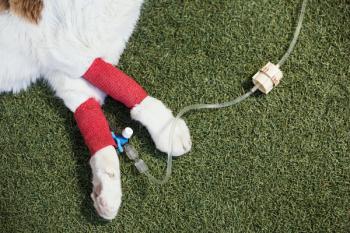
How specific is urine specific gravity?
An in-depth look at which urinary concentrating ability test might be best in your veterinary patients. (Part one of a four-part series.)
Suppose you are evaluating a persistently polyuric golden retriever. The serum chemistry profile results are normal. Evaluation of a urine sample reveals 3+ proteinuria (determined by reagent strip) and no abnormalities in the urine sediment. Which of the following test results obtained from a refrigerated urine sample (40 F) most accurately reflect urine concentrating capacity?
1. Urine osmolality = 1,400 mOsm/kg
2. Urine specific gravity = 1.025 measured by urinometer
3. Urine specific gravity = 1.014 measured by a reagent test
4. Urine specific gravity = 1.017 measured by a refractometer
What urine osmolalityand urine specific gravity measure
The kidneys excrete unwanted solute (urea, creatinine, minerals and other metabolic garbage) in a volume of water that is not required to maintain homeostasis. Elimination of unwanted solutes and water is the result of carefully regulated glomerular filtration, tubular reabsorption and tubular secretion.
Measurement of urine osmolality, either directly by osmometry or indirectly by evaluation of urine specific gravity, is the primary method used to evaluate the kidneys' response ability to concentrate (remove water in excess of solute) or dilute (remove solute in excess of water) urine according to varying needs. Thus, it is an index of tubular reabsorption. Knowledge of urine osmolality or specific gravity is extremely helpful when attempting to differentiate the underlying cause of polyuria and when localizing the pathophysiologic mechanisms of azotemia.
GETTY IMAGES
Another major indication for routine evaluation of urine specific gravity involves interpretation of other test results that are part of the complete urinalysis. Interpretation of other urinalysis test results are dependent on knowledge of specific gravity (or osmolality) since the specific gravity value provides information regarding the ratio of solutes to solvent (water). Semiquantitative interpretation of other test results is unfeasible in randomly obtained urine samples without knowledge of specific gravity. Consider proteinuria as an example: Does 2+ proteinuria at specific gravity of 1.010 reflect an equal or greater loss of protein than a 2+ proteinuria at 1.050? There is more protein in the less concentrated sample. The same concept is applicable to interpretation of positive test results for glucose, ketones, bilirubin, occult blood and constituents in urine sediment.
Osmotic concentration and osmometers
The clinical unit of osmotic concentration is the milliosmole (mOsm); 1 mOsm is defined as the quantity of a substance that dissociates to produce 1 millimole (mmol) of particles in solution.
Let's illustrate the concept this way: Consider the effects of relatively large albumin particles (molecular weight = 68,000), much smaller glucose molecules (molecular weight = 180) and tiny sodium chloride molecules (molecular weight = 58) on the osmolality of urine. Does albumin, glucose or sodium chloride have the greater effect on osmolality? We know 1 mmol of albumin provides 1 mOsm of solute because albumin does not dissociate in urine to form an increased quantity of solute. Likewise, 1 mmol of glucose provides 1 mOsm of solute because glucose does not dissociate in urine to form an increased quantity of solute. But 1 g/dl of glucose has a greater effect on osmolality than 1 g/dl of albumin because the number of particles in 1 g/dl of glucose is many times greater than the number of particles of albumin in 1 g/dl.
What about sodium chloride? In urine, 1 mmol of sodium chloride will dissociate to form 2 mOsm (one sodium ion and one chloride ion) in solution. Thus, a 1 g/dl solution of sodium chloride has many hundred times the osmotic activity of a 1 g/dl solution of albumin because undissociated and dissociated sodium chloride contribute many small molecules in large numbers while the same weight of protein contributes fewer large molecules.
However, because of their molecular weight, protein molecules could substantially affect specific gravity measurements. When urine contains 1 g/dl of protein, 0.003 must be subtracted from the observed specific gravity. In contrast, the effect of 1 g/dl of protein on urine osmolality is negligible (less than 1 mOsm/kg).
In clinical medicine, the osmotic concentration of solutions is usually measured with osmometers that determine freezing points (freezing point osmometers) or vapor pressure (vapor pressure osmometers). Now, consider this—as solute (e.g., sodium chloride) is added to urine:
> Osmotic pressure increases.
> Vapor pressure (the pressure at which rate of evaporation is equal to the rate of condensation) decreases.
> Boiling point increases.
> Freezing point decreases.
For example, 1 Osm of an ideal solute in 1 kg of water will have a freezing point of -1.86 C compared with pure water. Commercially manufactured osmometers determine osmolality by measuring relative changes in freezing point or vapor pressure of unknown solutions, using standard solutions as reference points. Currently available equipment uses microprocessors to provide rapid digital readout of data on samples as small as 0.2 ml. Unfortunately, compared with refractometers, osmometers are expensive.
Urine specific gravity
The density of a substance is the ratio of its mass (weight) to its volume. Density of urine reflects the total mass (which is related to weight and, thus, gravity) of all solutes per unit volume of solution. Stated another way, urine specific gravity is the ratio of the density (or weight) of urine to the density (or weight) of an equal volume of distilled water, both measured at the same temperature:
Specific gravity = Density of urine / Density of water
The specific gravity of water is 1.000 under conditions of standard temperature and pressure. If the density of urine were equal to the density of water, the specific gravity value would be 1.000. However, it is physiologically impossible for the kidneys to excrete pure water. Urine is more dense than water because it is composed of water and various solutes of different densities. Therefore, urine always has a specific gravity greater than 1.000.
Because specific gravity is a measurement of density, it is affected by the number of particles of solute present. Unfortunately, it is also affected by the molecular weight of each solute present. Therefore, there is only an approximate relationship between specific gravity and total solute concentration.
Each species of solute has its own characteristic effect on the specific gravity of urine. Urine samples having equivalent numbers of solute molecules per unit volume may have different specific gravity values if different mixtures of solutes are present.
For example, equal numbers of molecules of sodium chloride, albumin and glucose all have a different quantitative effect on specific gravity. Looking at this illustration in a slightly different context, adding 0.147 g of sodium chloride, 0.27 g of glucose or 0.4 g of albumin to 100 ml of urine will increase urine specific gravity by 0.001.
Although the weight of urine remains constant regardless of its temperature, the density of urine decreases with an increase in temperature. Conversely, the density of urine increases with a decrease in temperature. Therefore, for more precise work, the temperature of urine should be compared with the reference temperature of the instrument used to determine specific gravity.
Urinometers to measure urine specific gravity
A urinometer consists of a weighted glass bulb attached to a cylindrical stem designed to measure the specific gravity of urine. A scale calibrated in specific gravity units is etched on the surface or placed inside the cylindrical stem. Urinometers are calibrated at a reference temperature (usually close to room temperature). When placed in a solution such as urine, the urinometer displaces a volume of urine equal to its weight. The more solute that urine contains, the less volume the urinometer displaces. The fluid level is read at the bottom of the meniscus where urine intersects with the urinometer specific gravity scale.
Compared with refractometry and osmolality, the precision of urinometers is not great. One reason already mentioned is that urinometer measurements vary with temperature. It also may be difficult to read the meniscus. Another disadvantage is that there is a tendency for urinometers to drag against the side of narrow deep cylinders containing the urine sample. This may result in erroneous specific gravity values. In addition, a relatively large volume of urine (i.e., 5 to 15 ml or more depending on the size of the urinometer and the size of the container) is required in which to float this instrument.
Specific gravity reagent strips to measure urine specific gravity
The reagent strip specific gravity test is an indirect calorimetric method of assessing ionic urine specific gravity. Indirectly measuring urine specific gravity with test strips is based on the change in pK (dissociation constant) of a polyelectrolyte in the test pad in relation to the concentration of ionic (charged) solutes in urine. The test pad contains a polyelectrolyte and a pH indicator that are maintained at an alkaline pH.
When the test pad is immersed in urine, the polyelectrolyte reagent ionizes and releases protons (hydrogen ions) in proportion to the concentration of urine ionic analytes. The protons released from the polyelectrolyte decrease the pH of the test pad, causing a color change in the indicator dye from dark blue-green (specific gravity = 1.000) to yellow-green (specific gravity = 1.030). The greater the number of ionic solutes in urine, the greater the release of hydrogen ions from the test pad, and the greater the color change in the test pad indicator dye.
This method is not influenced by nonionic urine analytes such as urea or glucose. Therefore, specific gravity values determined by this method do not need to be corrected for significant quantities of urine glucose. However, the total specific gravity of urine is dependent on both ionic and nonionic solutes. Also, urine pH values of 6.5 or greater could influence test results because the indicator dye is active in this range.
Because the highest value that these reagent strips can detect is approximately 1.025 to 1.030, this test is unsatisfactory for detection of adequate renal concentrating capacity in dogs and cats. We have also found this test to be unreliable in less concentrated urine samples.
Urine refractive index and refractometers
Aqueous solutions such as urine contain substances that absorb various wavelengths of light. This may be measured by determining the refractive index of the light, which is defined as the ratio (or comparison) of the velocities of light in two different media. In the context of urine, the refractive index is the unitless ratio of the refraction of light in air compared with the refraction of light in urine. As the solute concentration of urine increases, the velocity of light passing from air through urine decreases and the light beam is refracted.
As a consequence, the light rays bend (i.e., the angle of light refraction changes). The index of refraction may be measured by an instrument called a refractometer. Refractometry provides an indirect assessment of osmolality and specific gravity. Small handheld refractometers calibrated to determine urine specific gravity are commonly used.
Measurement of the refractive index of urine is affected by the concentration of all solutes (ionic and nonionic) in urine. In addition to urine solute concentration, temperature affects the density (or specific gravity) of urine. Therefore, refractometers are calibrated at a reference temperature.
There is considerable variability in the quality and cost of refractometers. Ideally, refractometers should be calibrated by the manufacturer for the species studied by using urine samples of known specific gravity. Therefore, dog and cat urine require different scales. Those designed for physicians are calibrated for human urine.
Summary
Measurements made by osmometers, urinometers, reagent strips and refractometers are related but not interchangeable. Measurement of urine osmolality provides information that is more closely related to renal concentrating capacity than does specific gravity or refractive index. Osmometers provide more accurate assessment of osmolality of individual urine samples than refractometers or urinometers.
Urine specific gravity is a direct but not proportional function of the number of solute particles in urine. Urine specific gravity varies with the kind of solute present, whereas urine osmolality is independent of the type of solute present. Therefore, urine specific gravity provides only an estimation of osmolality. In this regard, specific gravity is not specific. Indirect measurement of urine specific gravity by refractometry is useful as a screening test of renal function. However, urine osmolality measured with osmometers should be used for patients with undiagnosed persistent polyuria when errors in assessment of renal function are of significant consequence.
Evaluation of specific gravity is essential when interpreting test results of the complete urinalysis. Refractometers are recommended over urinometers for determination of urine specific gravity because they provide more reproducible results, require a small sample size, are temperature-compensated and are technically easy to use.
Still have your answer to the question posed in the beginning of this article? Remember it for next month's Diagnote in which we will discuss the interpretation and misinterpretation of urine specific gravity.
Dr. Carl A. Osborne is the director of the Minnesota Urolith Center and a professor at the College of Veterinary Medicine at the University of Minnesota. Dr. Eugene Nwaokorie is pursuing a PhD at the University of Minnesota.
Newsletter
From exam room tips to practice management insights, get trusted veterinary news delivered straight to your inbox—subscribe to dvm360.



